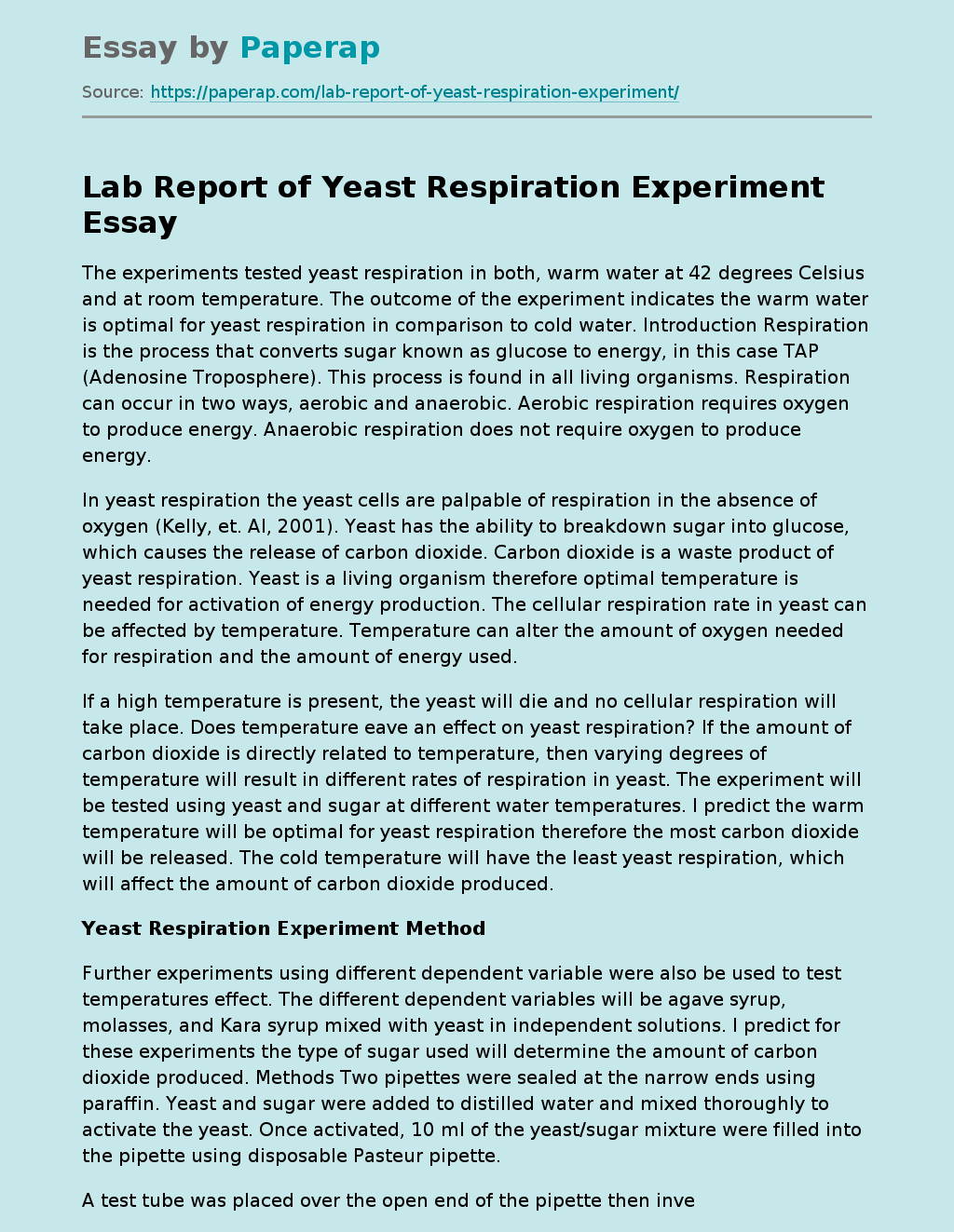Lab Report of Yeast Respiration Experiment
The experiments tested yeast respiration in both, warm water at 42 degrees Celsius and at room temperature. The outcome of the experiment indicates the warm water is optimal for yeast respiration in comparison to cold water. Introduction Respiration is the process that converts sugar known as glucose to energy, in this case TAP (Adenosine Troposphere). This process is found in all living organisms. Respiration can occur in two ways, aerobic and anaerobic. Aerobic respiration requires oxygen to produce energy.
Anaerobic respiration does not require oxygen to produce energy.
In yeast respiration the yeast cells are palpable of respiration in the absence of oxygen (Kelly, et. Al, 2001). Yeast has the ability to breakdown sugar into glucose, which causes the release of carbon dioxide. Carbon dioxide is a waste product of yeast respiration. Yeast is a living organism therefore optimal temperature is needed for activation of energy production. The cellular respiration rate in yeast can be affected by temperature. Temperature can alter the amount of oxygen needed for respiration and the amount of energy used.
If a high temperature is present, the yeast will die and no cellular respiration will take place. Does temperature eave an effect on yeast respiration? If the amount of carbon dioxide is directly related to temperature, then varying degrees of temperature will result in different rates of respiration in yeast. The experiment will be tested using yeast and sugar at different water temperatures. I predict the warm temperature will be optimal for yeast respiration therefore the most carbon dioxide will be released.
The cold temperature will have the least yeast respiration, which will affect the amount of carbon dioxide produced.
Yeast Respiration Experiment Method
Further experiments using different dependent variable were also be used to test temperatures effect. The different dependent variables will be agave syrup, molasses, and Kara syrup mixed with yeast in independent solutions. I predict for these experiments the type of sugar used will determine the amount of carbon dioxide produced. Methods Two pipettes were sealed at the narrow ends using paraffin. Yeast and sugar were added to distilled water and mixed thoroughly to activate the yeast. Once activated, 10 ml of the yeast/sugar mixture were filled into the pipette using disposable Pasteur pipette.
A test tube was placed over the open end of the pipette then inverted. The fluid level on the pipette was recorded. One tube was placed in a warm water bath at 42 degrees Celsius and the other was placed in a cold water bath at room temperature. The level of the liquid was recorded every five minutes until no more reading could be read. Four pipettes were sealed at the narrow ends using paraffin. Yeast and sugar were added to distilled water and mixed thoroughly to active the yeast. Another mixture was made with yeast and agave syrup.
Once yeast was activated in both solutions, 10 ml of the mixture were filled into the pipette using disposable Pasteur pipette. Yeast/sugar mixture was transferred into two pipettes. A test be was placed over the open end of the pipettes then inverted. The fluid level on the pipettes were recorded. Both tubes were placed in a warm water bath. Yeast/agave mixture was transferred into two pipettes. A test tube was placed over the open end of the pipettes then inverted. The fluid level on the pipettes were recorded. Both tubes were placed in a warm water bath.
The level of the liquid was recorded every five minutes until no more reading could be read. Two pipettes were sealed at the narrow ends using paraffin. Yeast and molasses were added to distilled water and mixed thoroughly to activate the yeast. Once activated, 10 ml of the yeast/molasses mixture were filled into the pipette using disposable Pasteur pipette. A test tube was placed over the open end of the pipette then inverted. The fluid level on the pipette was recorded. One tube was placed in a warm water bath and the other was placed in a cold water bath.
The level of the liquid was recorded every five minutes until no more reading could be read. Mixture was made with yeast and Kara syrup. Once yeast was activated in both Pasteur pipette. Yeast/sugar mixture was transferred into the pipette. A test tube was placed over the open end of the pipette then inverted. The fluid level on the pipette was recorded. The tube was placed in a warm water bath. Yeast/ Kara syrup mixture was transferred into the pipettes. A test tube was placed over the open end of the pipette then inverted. The fluid level on the pipette was recorded. The tube was also placed in a warm water bath.
The level of the liquid was recorded approximately even three to four minutes until no more reading could be read. Results The results indicate at the start of the experiment the reading was consistent for all three attempts using yeast and sugar placed in warm and cold water. In wow experiments the tubes placed in the warm water bath both produced more carbon dioxide faster than the tube in cold water, whereas in the third experiment there was no change then a sudden change in both tubes. See Table 1. 0 -1. 2 for results. Table 1. 0 Comparison between temperatures effect on yeast respiration.
Lab Report of Yeast Respiration Experiment. (2019, Dec 05). Retrieved from https://paperap.com/lab-report-of-yeast-respiration-experiment/

